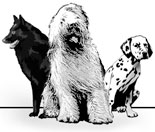A Rough Summer -- September 5, 2013
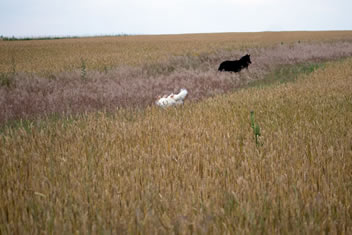
Bing and Tango up in the field near our pond. Notice that
Tango is in the midst of flipping upside down!
Two evenings later, Bing lay at my feet as I watched a baseball game. He was snoozing away, and breathing like a pug. Jeez, I thought, he’s getting old! Preparing for bed, I went to take off his collar, and he squealed and pulled back.

Typical Grass awn
I had to work, so Pete took Bing to the vet. Being Bing, he had to be anaesthetized to be looked at. I had my definite theory about the grass awn, but the vet team was unable to see anything definite. What he did see, though, was a very swollen area near the epiglottis. The vet was not comfortable doing anything with this issue, and wanted me to have him looked at by a specialist. He came home on antibiotics and prednisone.
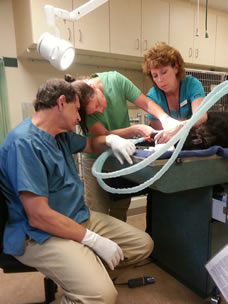
Bing under sedation
at Country Doctor
Pete went with me to Penn; we were both extremely concerned for his health. We saw Dr Gross, an internist. She was AWESOME and I highly recommend her. Long story short, she managed to pull together multiple teams (anesthesiology, dentistry, radiology, and her internist team) to put him under and look at him THAT DAY. Apparently, this is unheard of! Not only was this great news, it gets better. All she found was a large area that had been swollen but had deflated. We could only surmise that he had a reaction to something that had gotten into his throat…such as a grass awn! She wanted us to keep him on the antibiotics and extend his prednisone for a few more weeks.
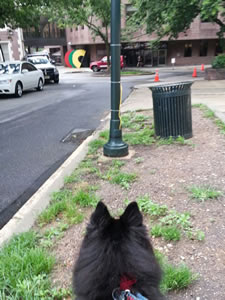
Bing goes out for a potty break
while waiting for the "team" to be
assembled at the University of
Pennsylvania's veterniary hospital.
Bing chose not to use his voice for about a week after that, and slowly his bark came back to what it had been. He had no raspy breathing, and no sensitivity to the touch. He healed beautifully and we were thrilled. He finished his prednisone at the end of July. I thought we were out of the woods.
Nope.
In the first and second weeks of August, I noticed that a wart he had on his snout was red, inflamed, open and weeping. Sometimes it bled. Trying not to panic, I took him in to get it looked at when Tango went in for his shots. The vet gave me options, and I chose to try some topical antibiotic for a week to see what happens. I just couldn’t bear the thought of more anesthesia for him to have it removed and biopsied. He went under twice in 5 days; that was enough for a while. I also had her look at his eyes, as they were bright red when he woke up that day, as were Tango’s. I had heard that ragweed was particularly bad that day, so I chalked it up to that. That was Thursday.
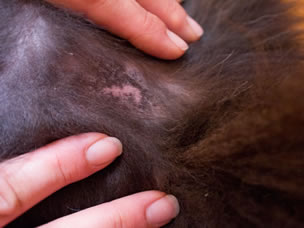
One of three hot spots, this one on Bing's
elbow, now almost completely healed.
Years ago I knew of a German Shepherd who lost most of his tail to amputation because he had a lesion and they simply could not get enough skin to close the wound. Bing’s hotspot was at the base of his tail; if this happened, he’d lose his entire tail. It was panicking at this thought that convinced me to get that Willard’s Water.
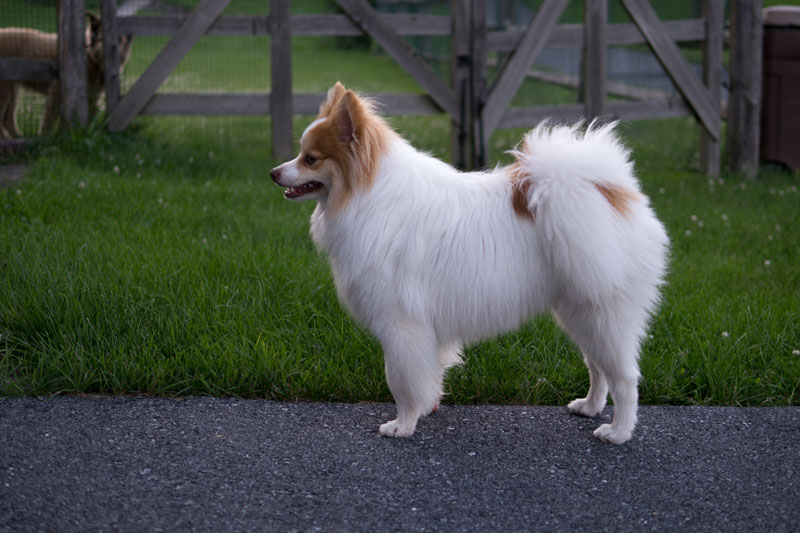
Tango poses in the driveway near the barn,
Harriet peers out from behind the fence
I believe that a few things have contributed to Bing’s Bad Summer. 1) A month of Prednisone. It is a miracle drug, and I don’t regret using it, particularly for an airway. But it takes a huge toll on the immune system. 2) He was sedated twice. That has to take a toll. 3) I went away three times after that episode, and that is stressful for him. 4) This has been an absolutely horrible summer for rain and bugs and environmental assaults. And 5) Bing grew up on and has lived on a mostly raw diet. In the past few months, I have been feeding him a lot of good quality kibble. I think his body was simply not used to it, and being already compromised, he just couldn’t handle it. All of these things left his body open to environmental war.
So we are on the mend, and I really am hoping we don’t have yet another trauma. Harriet and Tango were not without their issues this summer, either. Harriet had some challenges with walking due to grooming pressure on her damaged spinal cord, and then had Vestibular issues with her ears. Tango had a reaction to his vaccines. I’ve had enough!
The take-home lesson for this is to really be careful not to tax our immune systems too much….we need them, and can’t abuse them!
Ali
Bing Blog 65
